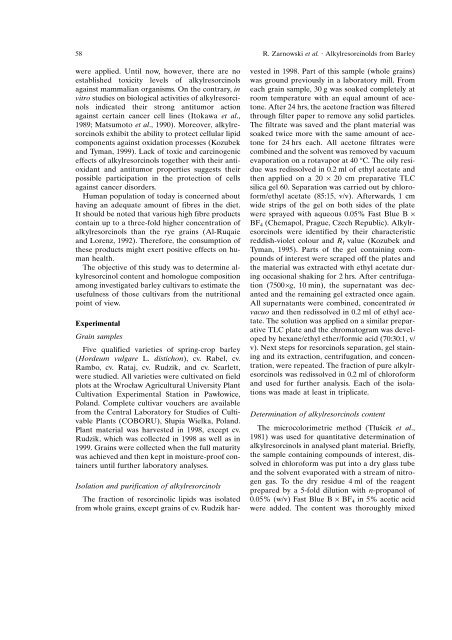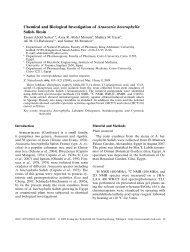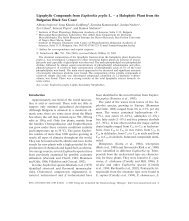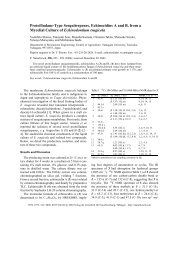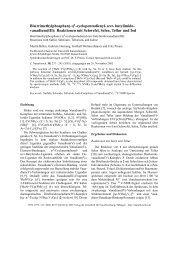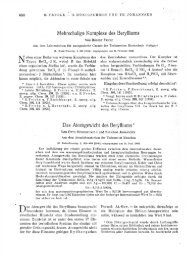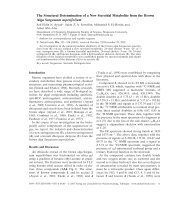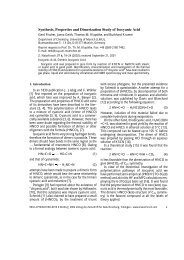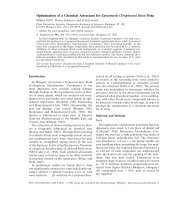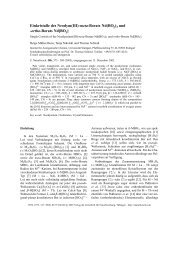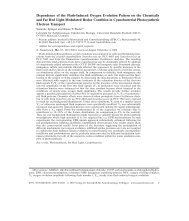Alkylresorcinols in Barley (Hordeum vulgare L. distichon) Grains
Alkylresorcinols in Barley (Hordeum vulgare L. distichon) Grains
Alkylresorcinols in Barley (Hordeum vulgare L. distichon) Grains
You also want an ePaper? Increase the reach of your titles
YUMPU automatically turns print PDFs into web optimized ePapers that Google loves.
58 R. Zarnowski et al. · Alkylresorc<strong>in</strong>olds from <strong>Barley</strong><br />
were applied. Until now, however, there are no<br />
established toxicity levels of alkylresorc<strong>in</strong>ols<br />
aga<strong>in</strong>st mammalian organisms. On the contrary, <strong>in</strong><br />
vitro studies on biological activities of alkylresorc<strong>in</strong>ols<br />
<strong>in</strong>dicated their strong antitumor action<br />
aga<strong>in</strong>st certa<strong>in</strong> cancer cell l<strong>in</strong>es (Itokawa et al.,<br />
1989; Matsumoto et al., 1990). Moreover, alkylresorc<strong>in</strong>ols<br />
exhibit the ability to protect cellular lipid<br />
components aga<strong>in</strong>st oxidation processes (Kozubek<br />
and Tyman, 1999). Lack of toxic and carc<strong>in</strong>ogenic<br />
effects of alkylresorc<strong>in</strong>ols together with their antioxidant<br />
and antitumor properties suggests their<br />
possible participation <strong>in</strong> the protection of cells<br />
aga<strong>in</strong>st cancer disorders.<br />
Human population of today is concerned about<br />
hav<strong>in</strong>g an adequate amount of fibres <strong>in</strong> the diet.<br />
It should be noted that various high fibre products<br />
conta<strong>in</strong> up to a three-fold higher concentration of<br />
alkylresorc<strong>in</strong>ols than the rye gra<strong>in</strong>s (Al-Ruqaie<br />
and Lorenz, 1992). Therefore, the consumption of<br />
these products might exert positive effects on human<br />
health.<br />
The objective of this study was to determ<strong>in</strong>e alkylresorc<strong>in</strong>ol<br />
content and homologue composition<br />
among <strong>in</strong>vestigated barley cultivars to estimate the<br />
usefulness of those cultivars from the nutritional<br />
po<strong>in</strong>t of view.<br />
Experimental<br />
Gra<strong>in</strong> samples<br />
Five qualified varieties of spr<strong>in</strong>g-crop barley<br />
(<strong>Hordeum</strong> <strong>vulgare</strong> L. <strong>distichon</strong>), cv. Rabel, cv.<br />
Rambo, cv. Rataj, cv. Rudzik, and cv. Scarlett,<br />
were studied. All varieties were cultivated on field<br />
plots at the Wrocław Agricultural University Plant<br />
Cultivation Experimental Station <strong>in</strong> Pawłowice,<br />
Poland. Complete cultivar vouchers are available<br />
from the Central Laboratory for Studies of Cultivable<br />
Plants (COBORU), Słupia Wielka, Poland.<br />
Plant material was harvested <strong>in</strong> 1998, except cv.<br />
Rudzik, which was collected <strong>in</strong> 1998 as well as <strong>in</strong><br />
1999. Gra<strong>in</strong>s were collected when the full maturity<br />
was achieved and then kept <strong>in</strong> moisture-proof conta<strong>in</strong>ers<br />
until further laboratory analyses.<br />
Isolation and purification of alkylresorc<strong>in</strong>ols<br />
The fraction of resorc<strong>in</strong>olic lipids was isolated<br />
from whole gra<strong>in</strong>s, except gra<strong>in</strong>s of cv. Rudzik har-<br />
vested <strong>in</strong> 1998. Part of this sample (whole gra<strong>in</strong>s)<br />
was ground previously <strong>in</strong> a laboratory mill. From<br />
each gra<strong>in</strong> sample, 30 g was soaked completely at<br />
room temperature with an equal amount of acetone.<br />
After 24 hrs, the acetone fraction was filtered<br />
through filter paper to remove any solid particles.<br />
The filtrate was saved and the plant material was<br />
soaked twice more with the same amount of acetone<br />
for 24 hrs each. All acetone filtrates were<br />
comb<strong>in</strong>ed and the solvent was removed by vacuum<br />
evaporation on a rotavapor at 40 ∞C. The oily residue<br />
was redissolved <strong>in</strong> 0.2 ml of ethyl acetate and<br />
then applied on a 20 ¥ 20 cm preparative TLC<br />
silica gel 60. Separation was carried out by chloroform/ethyl<br />
acetate (85:15, v/v). Afterwards, 1 cm<br />
wide strips of the gel on both sides of the plate<br />
were sprayed with aqueous 0.05% Fast Blue B ¥<br />
BF 4 (Chemapol, Prague, Czech Republic). <strong>Alkylresorc<strong>in</strong>ols</strong><br />
were identified by their characteristic<br />
reddish-violet colour and R f value (Kozubek and<br />
Tyman, 1995). Parts of the gel conta<strong>in</strong><strong>in</strong>g compounds<br />
of <strong>in</strong>terest were scraped off the plates and<br />
the material was extracted with ethyl acetate dur<strong>in</strong>g<br />
occasional shak<strong>in</strong>g for 2 hrs. After centrifugation<br />
(7500 ¥g, 10 m<strong>in</strong>), the supernatant was decanted<br />
and the rema<strong>in</strong><strong>in</strong>g gel extracted once aga<strong>in</strong>.<br />
All supernatants were comb<strong>in</strong>ed, concentrated <strong>in</strong><br />
vacuo and then redissolved <strong>in</strong> 0.2 ml of ethyl acetate.<br />
The solution was applied on a similar preparative<br />
TLC plate and the chromatogram was developed<br />
by hexane/ethyl ether/formic acid (70:30:1, v/<br />
v). Next steps for resorc<strong>in</strong>ols separation, gel sta<strong>in</strong><strong>in</strong>g<br />
and its extraction, centrifugation, and concentration,<br />
were repeated. The fraction of pure alkylresorc<strong>in</strong>ols<br />
was redissolved <strong>in</strong> 0.2 ml of chloroform<br />
and used for further analysis. Each of the isolations<br />
was made at least <strong>in</strong> triplicate.<br />
Determ<strong>in</strong>ation ofalkylresorc<strong>in</strong>ols content<br />
The microcolorimetric method (Tłus´cik et al.,<br />
1981) was used for quantitative determ<strong>in</strong>ation of<br />
alkylresorc<strong>in</strong>ols <strong>in</strong> analysed plant material. Briefly,<br />
the sample conta<strong>in</strong><strong>in</strong>g compounds of <strong>in</strong>terest, dissolved<br />
<strong>in</strong> chloroform was put <strong>in</strong>to a dry glass tube<br />
and the solvent evaporated with a stream of nitrogen<br />
gas. To the dry residue 4 ml of the reagent<br />
prepared by a 5-fold dilution with n-propanol of<br />
0.05% (w/v) Fast Blue B ¥ BF 4 <strong>in</strong> 5% acetic acid<br />
were added. The content was thoroughly mixed


